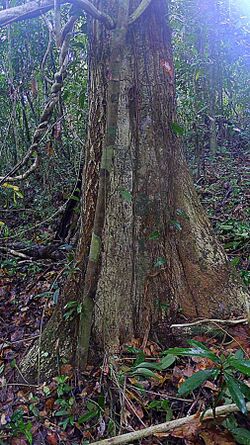Biology:Micropholis
| Micropholis | |
|---|---|

| |
| Micropholis crassipedicellata | |
| Scientific classification | |
| Kingdom: | Plantae |
| Clade: | Tracheophytes |
| Clade: | Angiosperms |
| Clade: | Eudicots |
| Clade: | Asterids |
| Order: | Ericales |
| Family: | Sapotaceae |
| Subfamily: | Chrysophylloideae |
| Genus: | Micropholis (Griseb.) Pierre |
| Synonyms[1][2] | |
| |
Micropholis is group of trees in the family Sapotaceae, described as a genus in 1891.[3][1][4]
These trees are native to tropical South America, Mesoamerica, and the West Indies.[2] Most are locally known as "cafetos", literally meaning "coffee plants". But while both Micropholis and the coffeeplant genus Coffea are asterids, the present genus is part of the Ericales – a quite basal asterid lineage –, while Coffea belongs to the more advanced Gentianales.
They are valued for their wood, which is used as timber, for construction and as firewood; many species are threatened by overexploitation and habitat destruction. Also, they are often used as part of catuaba, a decoction from various tree's bark claimed to have aphrodisiac and stimulant properties.
Caimitillo verde (M. garciniifolia) is an important food source of the nearly-extinct Puerto Rican amazon bird (Amazona vittata).
- Species[2]
References
- ↑ 1.0 1.1 Tropicos, Micropholis (Griseb.) Pierre
- ↑ 2.0 2.1 2.2 Kew World Checklist of Selected Plant Families
- ↑ Pierre, Jean Baptiste Louis. 1891. Notes Botaniques: Sapotacées 2: 37–38
- ↑ Govaerts, R.; Harvey, Y.; Jessup, L.; Pennington, T.D. & Vink, W. (2001): World Checklist of Sapotaceae – Micropholis. The Board of Trustees of the Royal Botanic Gardens, Kew. Retrieved 2008-DEC-24.
Wikidata ☰ Q2709804 entry
 |

